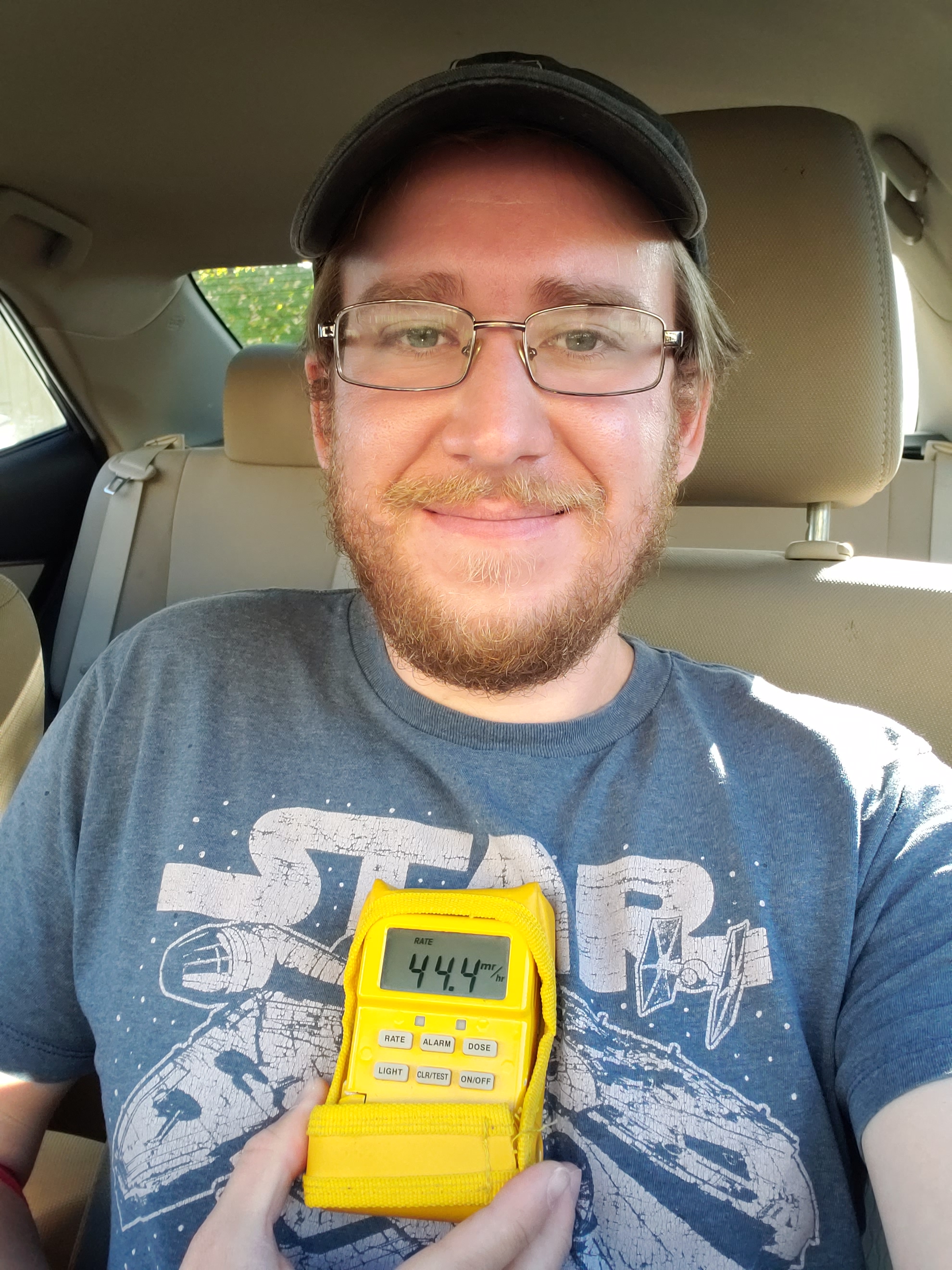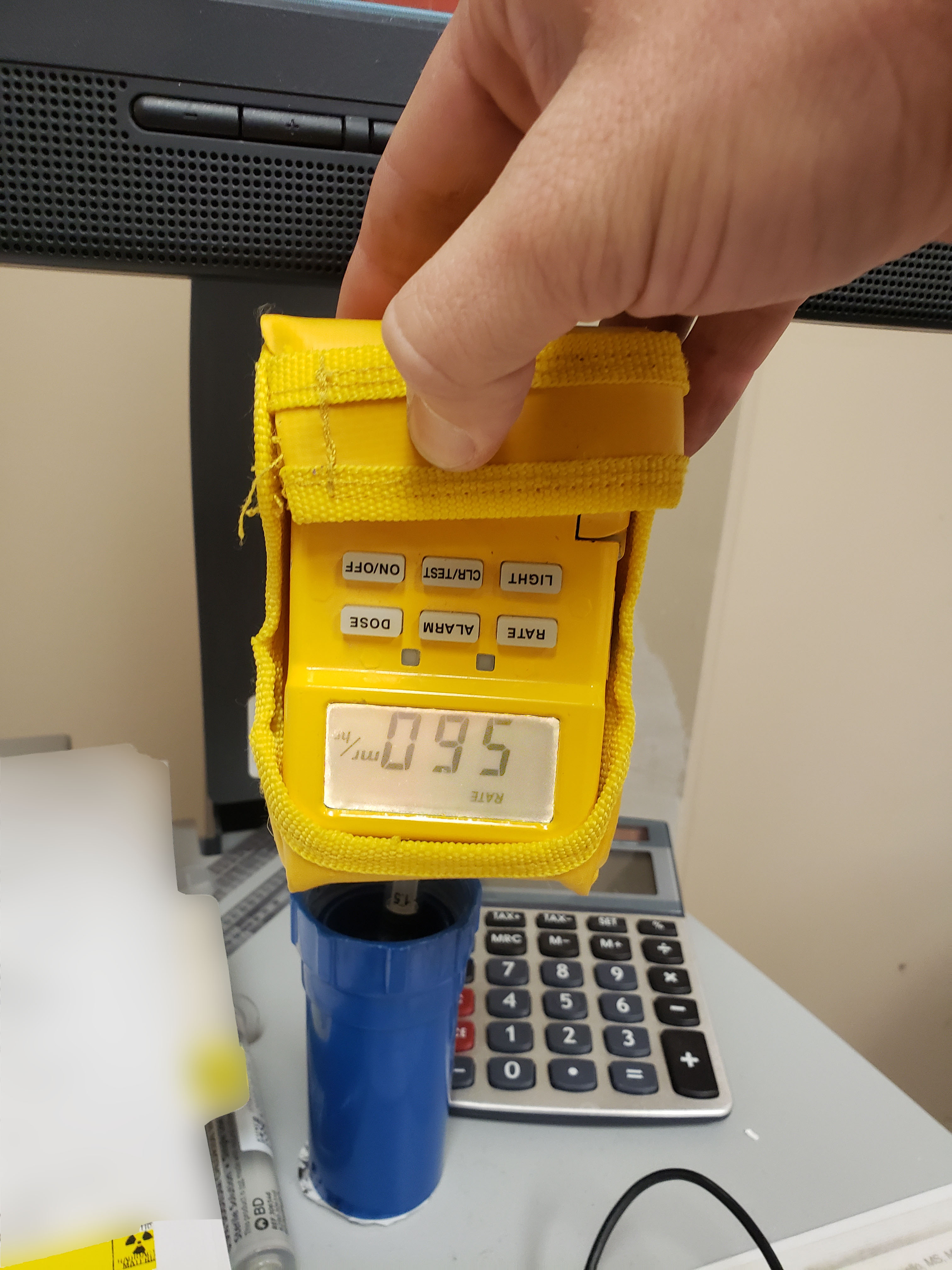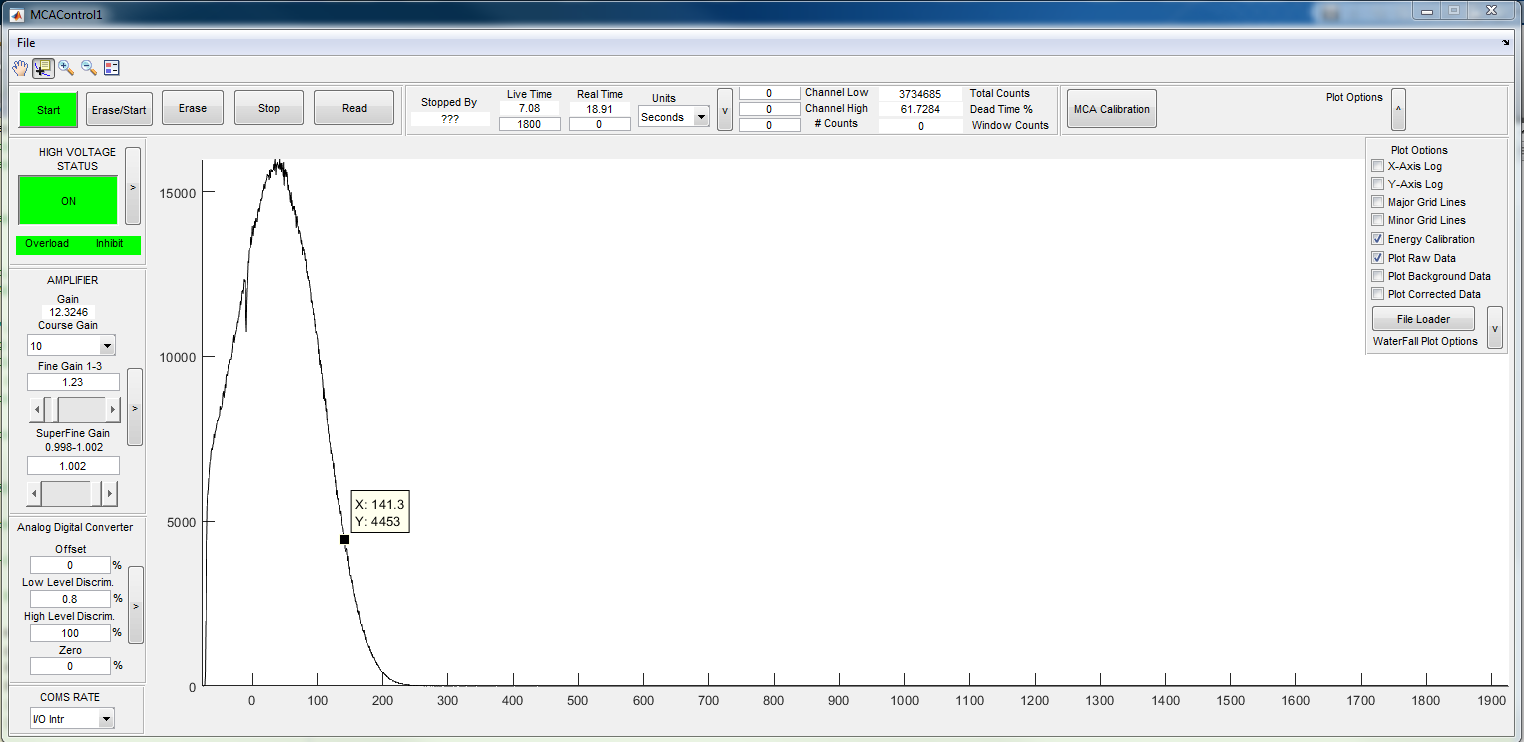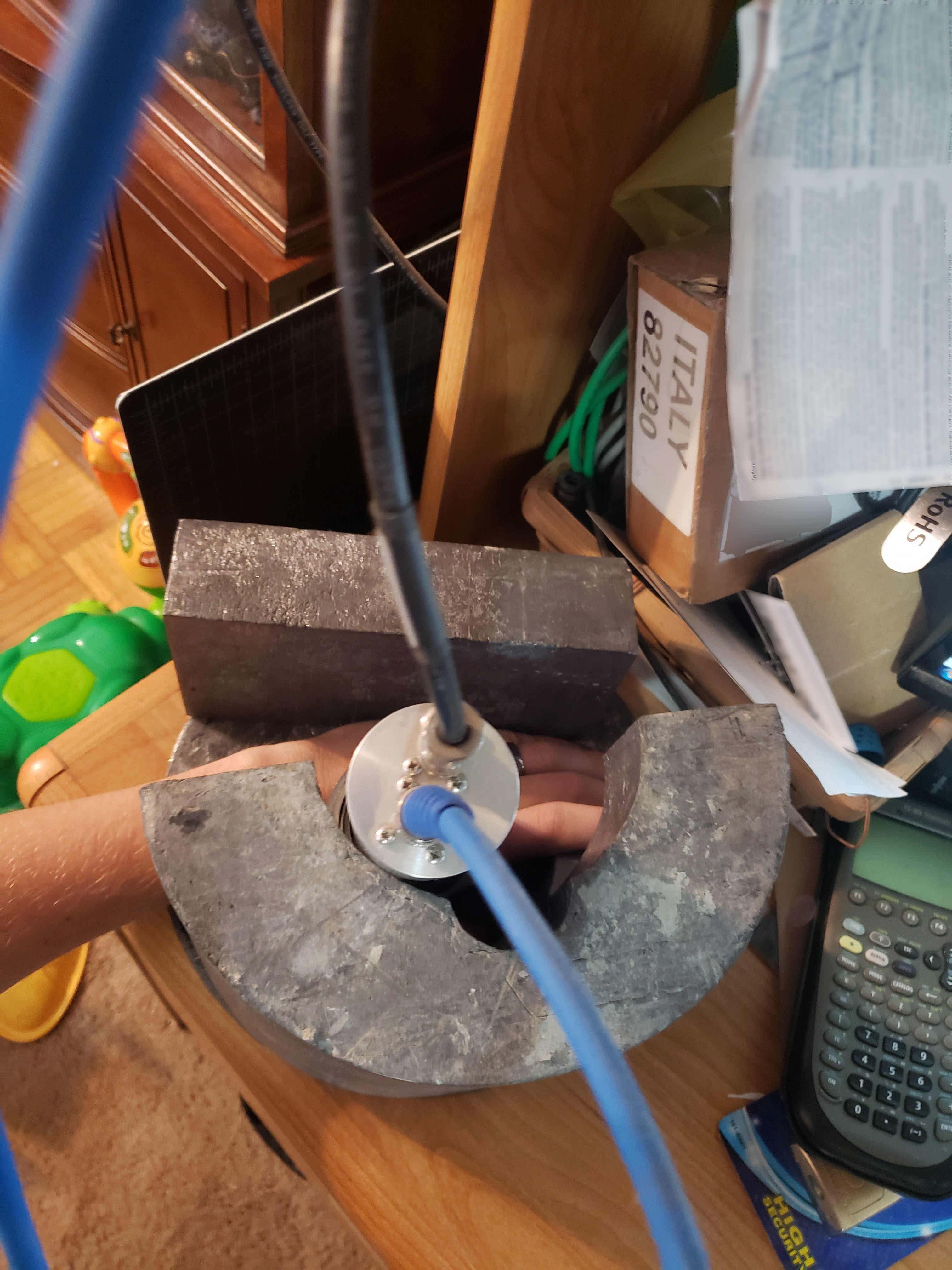Tc-99m : Cardiac Stress Test
Author: Jay Howson
November 2021
In September of 2021 at a fairly routine cardiologist appointment, I was informed my EKG shows evidence of my having had a heart attack.
Which was news to me.
Needless to say, the doctor ordered an array of tests, and was very surprised to watch me put my hands up and cheer when they told me one of them would be a nuclear stress test.
For I knew the opportunity to become my own spectral source for a short time was rare indeed.
To quote my mother after I sent her the below pic of me in the car with the UltraRadiac.
“Only Jay would find this thrilling”
Mom, It takes a special person to find the silver (or in this case Technetium) lining in ones medical downturns.
The good news as a result of all the tests I went thru, is that apparently i’m fine! They found no evidence of a heart attack. Woot!
I kind of wish they had just run the EKG again to see if the first one was in error instead of giving me anxiety for a month, but I guess the medical industrial complex skips that and goes right to radioactive injections, shrug. Also I wouldn’t have had this adventure if they had, so i’m ok with it.

Strangely they did not tell me I wasn’t allowed to do anything or go anywhere.
Perhaps they assumed I already knew better due to my antics.
When I showed up for my test I amused my Tech greatly by having my Canberra UltraRadiac sitting next to my arm and proceeded to observe some of the highest readings I have seen on this little guy. Only to be topped a short while later after the 2nd injection. The Chemical that they actually inject is called myoview, info on it can be found here: Myoview manual.
Here is a run down of my procedure from my perspective.
- Arrive at testing facility, no prep is needed aside from not consuming any caffeine and the like.
- Receive a 10mCi Tc-99m solution via intravenous injection, and have EKG pads placed on chest.
- Imagery is taken via the gamma camera, synced to you heart beat via the EKG
- You are exercised on a treadmill set to increase speed every 2 minutes or so. The goal is to reach 160 beats per minute. Your EKG is recorded during the duration of the exercise.
- Immediately following the exercise, an additional 30mCi of Tc-99m solution is injected Intravenously. All but 3 of the EKG pads are removed.
- Once again imagery is taken with the gamma camera synced to your heart rate via the EKG pads.
- The EKG pads are removed, you are free to leave. No specific post procedure guidance was given.
While I am unclear why they use two different injections; I believe it has something to do with how the Tc-99m penetrates your tissue. You are looking at blood vessels, so you probably want the strongest signal to be present in your blood stream. After being exercised your blood vessels dilate, and you should be able to see additional capillaries you could not see before that have opened up more. But alas, I am a physicist not a doctor so don’t quote me on any of this.
Where would we be without the pictures the doctors actually took.
No idea what any of it means, but here they are. Interesting to look at.
Now, a good question from those who are looking at the page out of curiosity preparing for a procedure would be.
How is this safe?
The injection of radioactive material surely can’t be safe at all, right?
Believe it or not, these tests fall into the same category of radiation hazard as X-rays. The Tc-99m emits a 140.5 KeV gamma ray being the isotopes only decay mode of relevance (more of that later), being a high energy photon just like an X-Ray it will excite an imaging plate in the exact same way.
It is true that the test exposes you to much more radiation than an X-Ray would, but getting these kinds of images with an X-Ray just isn’t practical.
In situations involving the heart; understanding the level of existing damage and providing proper treatment is of significant benefit when compared to the potential long term risks due to the tests radiation exposure.
So you answer the question, is this safe? Yes.
The procedure simply adds to your lifetime radiation dose, as does every other X-Ray you receive, flight you take, and banana you eat.
Another common question is;
Where does the Tc-99m go?
The answer to that question is 2 fold.
Here is the short version if you dont feel like reading
1) It decays into Tc-99 Resulting in a very low activity.
2) It is removed from your body as waste and gets flushed down the toilet.
And the long far more interesting answers.
1) The Tc-99m decays into Tc-99 with a half life of ~6 hours. Half life is the time is takes for half of the material to decay and is governed by this simple formula.
The relatively short half life of ~6hrs means that the activity produced by a small amount of initial material will be high. The short half life works in our favor here as we only need a teeny tiny quantity of material to produce the levels of activity necessary for the test, and once the test is done it decays away very quickly. So we have this relatively short burst of strong gamma activity from the Tc-99m which decays into Tc-99, a beta emitter with a half life of 211,000 years, which then decays into non-radioactive Ruthenium Ru-99.
We can easily calculate the mass of Tc-99m was required for our 40mCi worth of injection activity (m meaning mili, and Ci standing for Curies, a unit named in honor of Marie Curie). A high quantity of activity relative to the normal levels civilians typically encounter on a daily basis.
Tc-99m has a specific activity of 5,243,820 Ci/g.
Dividing our injection of 40mCi by the specific activity yields an injected mass of 7.628ng of Tc-99m. That’s 7.6 nano grams, not very much mass at all.
But this mass value is useful, as we can easily calculate an upper limit on the activity level for the resulting Tc-99, which has a specific activity of 1.7E-2 Ci/g. Our mass of 7.628ng multiplied by our Tc-99 specific activity equals 0.1297nCi. An activity value at the low end of things, almost a billion times less than what we started with.
To put this into comparison for you as an individual, the naturally occurring quantity of radioactive potassium (K-40) present in your body has an activity of around 115nCi.
But, just the half life decay is not all that happens to the Tc-99m that is placed into your body. It is also removed from your body, via biological processes.
2) The Tc-99m and Tc-99 decay via a radioactive half life and are flushed from your body via your urine, a process which has a biological half life.
The specific chemical used for my test is called Myoview, the Tc-99m is complexed with another chemical called tetrofosmin. This complexing aids your body is removing the compound from the body as quickly as possible.
To quote the product manual, viewed here Myoview Tc-99.
“Approximately 66% of the injected activity is excreted within 48 hours post-injection, with approximately 40% excreted in the urine and 26% in the feces.”
So, the full answer to the question Where does it all go?
1) It decays into Tc-99 Resulting in a very low activity
2) It is removed from your body as waste and gets flushed down the toilet.
The fact that nuclear medicine byproducts are disposed of in the house hold septic and sewer is pretty funny considering how absolutely anal the nuclear industry in general is about their waste.
I was told a story where a nuclear medicine patient who happened to work as a truck driver delivered some goods to a nuclear plant, and peed on the ground behind his truck. When he was leaving he set off the alarms and they were none too pleased to discover he had deposited his Tc-99m/Tc-99 into their top soil. Tc-99 is a fission product, ie its made within the reactor itself as a byproduct. Any environmental leakage could come back and implicate the power plant in any number of issues, even though this dudes pee had nothing to do with the reactor. Needless to say, the professionals came out and immediately dug up that dirt, bagged it up and disposed of it the same way they would any of their actual rad waste.
Regardless, the very low activity and low mass that these tests result in after about a week is the reason flushing it at your house is acceptable. It is so small that it barely matters in the grand scheme of things, there are just so many other things that have far more activity than one of these tests. An ionizing smoke detector will have 10,000 times more activity in the Am-241 source within, not to mention the naturally occurring isotopes that are already found everywhere.
Now for Some Spectroscopy!


The Main peak at 140.5 Kev can be seen in the center, the peaks to the left are X-ray florescence peaks from my lead cave, and contaminants in the urine sample.
The 2 smaller peaks to the right are summation peaks. The 1st being a sum of the 140.5Kev Tc-99m gamma and an ~80Kev Lead florescence X-Ray, and the 2nd being a sum of two 140.5 KeV Tc-99m Gammas. Of Course a Compton continuum for all these peaks also exists.
A nice thing about using Matlab to control everything is it’ts pretty easy to get the system to do what I need it to do while i’m not paying attention do it. so I let the computer collect data for a few days to look at the half life.

(Y axis auto scaled to show the entire decay)



The Gap is where I had a computer error and no data exists.
Non-linearity on the log plot is first due to detector pile-up, later in time I believe there existed some form of voltage instability, but I am not sure. Another source of error would be my count duration verses my interval, having a measure of instantaneous count rate would probably be better.

Of course, Tim has an HPGE detector he keeps cool at all times. So I headed over to his house and stuck my hand into the lead castle. As well as provided another petri dish with a 10ml urine sample for an HPGE half life measurement.




Naturally. the attempt at measuring half life was much cleaner using Tims setup.

The measured half life was accurate to within 1%. Id call that a win. The line of best fit, is barely visible in the data line, along with the known half life.


Sadly I must report, I remain superpower free after my adventure. Oh well.
But also this experiment is not yet concluded, there is more to come.
The contents of this page are my own and Tim’s and may not be reproduced elsewhere without written permission from myself.















